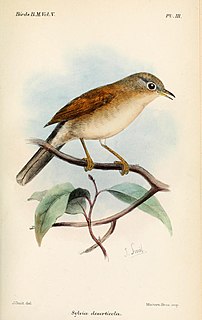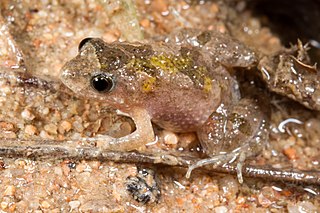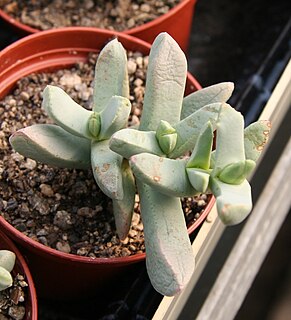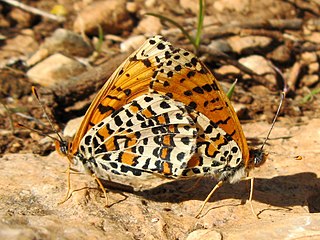
A conservation-dependent species is a species which has been categorised as "Conservation Dependent" ("LR/cd") by the International Union for Conservation of Nature (IUCN), i.e. as dependent on conservation efforts to prevent it from becoming vulnerable to endangerment. Such species must be the focus of a continuing species-specific and/or habitat-specific conservation programme, the cessation of which would result in the species qualifying for one of the threatened categories within a period of five years.

Tristram's warbler is a species of Old World warbler in the family Sylviidae. It is found in Algeria, Libya, Mauritania, Morocco, Tunisia, and Western Sahara. Its natural habitat is subtropical dry shrubland.

The desert froglet is a species of frog in the family Myobatrachidae, endemic to Australia. The species is not under any threat of extinction. Desert froglets occur mainly in dry or moist savanna habitats, principally from the mid-western border of Northern Territory, south-east into western Queensland and New South Wales and the north-east corner of South Australia. They can also be found along the Queensland coast where it has been recorded between Townsville and Cooktown, and as far south as Hervey Bay.
Psychomastatix deserticola is a species of grasshopper in the family Eumastacidae. It is endemic to the United States. It is known commonly as the desert monkey grasshopper.
Spaniacris deserticola is a species of grasshopper in the family Romaleidae known as the Coachella Valley grasshopper and spanistic desert grasshopper. It is known from a few locations in the deserts of southern California and just across the border in Sonora, Mexico.

Helicia is a genus of 110 species of trees and shrubs, constituting part of the plant family Proteaceae. They grow naturally in rainforests throughout tropical South and Southeast Asia, including India, Sri Lanka, Indochina, Peninsular Malaysia to New Guinea and as far south as New South Wales.

Juttadinteria is a genus of plants in the family Aizoaceae.
Juttadinteria kovisimontana is a species of plant in the family Aizoaceae. It is endemic to Namibia. Its natural habitat is cold desert.
Juttadinteria simpsonii is a species of plant in the family Aizoaceae. It is endemic to Namibia. Its natural habitats are rocky areas and cold desert. It is threatened by habitat loss.
Juttadinteria suavissima is a species of plant in the family Aizoaceae. It is endemic to Namibia. Its natural habitat is cold desert.

Cistanche is a worldwide genus of holoparasitic desert plants in the family Orobanchaceae. They lack chlorophyll and obtain nutrients and water from the host plants whose roots they parasitize.

Diorhabda carinulata is a species of leaf beetle known as the northern tamarisk beetle, which feeds on tamarisk trees from southern Russia and Iran to Mongolia and western China. This beetle is used in North America as a biological pest control agent against saltcedar or tamarisk, an invasive species in arid and semiarid ecosystems.

Agaricus deserticola, commonly known as the gasteroid agaricus, is a species of fungus in the family Agaricaceae. Found only in southwestern and western North America, A. deserticola is adapted for growth in dry or semi-arid habitats. The fruit bodies are secotioid, meaning the spores are not forcibly discharged, and the cap does not fully expand. Unlike other Agaricus species, A. deserticola does not develop true gills, but rather a convoluted and networked system of spore-producing tissue called a gleba. When the partial veil breaks or pulls away from the stem or the cap splits radially, the blackish-brown gleba is exposed, which allows the spores to be dispersed.

The World's 25 Most Endangered Primates is a list of highly endangered primate species selected and published by the International Union for Conservation of Nature (IUCN) Species Survival Commission (SSC) Primate Specialist Group (PSG), the International Primatological Society (IPS), Global Wildlife Conservation (GWC), and Bristol Zoological Society (BZS). The IUCN/SSC PSG worked with Conservation International (CI) to start the list in 2000, but in 2002, during the 19th Congress of the International Primatological Society, primatologists reviewed and debated the list, resulting in the 2002–2004 revision and the endorsement of the IPS. The publication was a joint project between the three conservation organizations until the 2012–2014 list when BZS was added as a publisher. The 2018–2020 list was the first time Conservation International was not among the publishers, replaced instead by GWC. The list has been revised every two years following the biannual Congress of the IPS. Starting with the 2004–2006 report, the title changed to "Primates in Peril: The World's 25 Most Endangered Primates". That same year, the list began to provide information about each species, including their conservation status and the threats they face in the wild. The species text is written in collaboration with experts from the field, with 60 people contributing to the 2006–2008 report and 85 people contributing to the 2008–2010 report. The 2004–2006 and 2006–2008 reports were published in the IUCN/SSC PSG journal Primate Conservation,, since then they have been published as independent publications.

Melitaea deserticola, the desert fritillary, is a butterfly of the family Nymphalidae. It is found in North Africa, Lebanon, Israel, Jordan, Saudi Arabia and Yemen.
Helianthus deserticola, the desert sunflower, is a plant species native to Arizona, Nevada and Utah. It grows in dry, sun-lit locations at elevations of 400–1,500 m (1,300–4,900 ft).
Masasteron is a genus of spiders in the family Zodariidae. It was first described in 2004 by Baehr. As of 2017, it contains 21 Australian species.
Psychomastax deserticola, the desert monkey grasshopper, is a species of monkey grasshopper in the family Eumastacidae. It is found in North America.
Saxinis deserticola is a species of case-bearing leaf beetle in the family Chrysomelidae. It is found in Central America and North America.
Lithostege deserticola is a species of moth in the family Geometridae first described by William Barnes and James Halliday McDunnough in 1916. It is found in North America.











